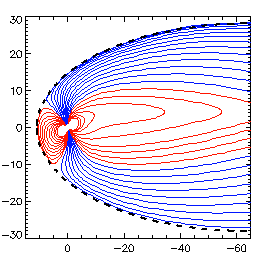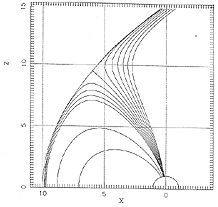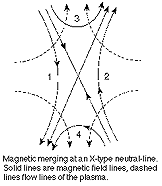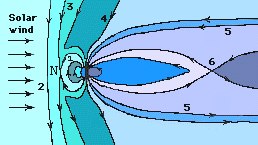|
The northward flowing group would migrate to line "3" in the drawing, an "open magnetic field line" linking Earth to interplanetary space. A short time later the field line linking those particles will occupy position "4", then "5". Dungey proposed that the process was reversed at some distant neutral point (or neutral line) "6" in the far tail, as illustrated here by a figure adapted from his original article. There the interplanetary line halves were reunited and flowed away, and the ends connected to Earth were also joined up again.
Since the nose of the magnetosphere (on the average) maintains its position and is not "worn away" by the reconnection process, the magnetic field lines swept into the tail, and the plasma particles strung along them, must somehow flow back towards Earth, inside the magnetosphere. This (according to Dungey) explained the large-scale sunward flow of the tail, deduced from auroral motions and flows in the polar ionsphere, on field lines which extended into the tail.
Dungey's process of "magnetic reconnection" is expected to increase the flow of energy from the solar wind to the magnetosphere, by establishing a direct field-line link between the two. It does, however, require a southward slant of interplanetary magnetic field lines, a condition which only exists about half the time.
In 1966, soon after regular observations of the IMF began, a student of Dungey, Don Fairfield, did in fact note a strong correlation between such southward slants and the storminess of the magnetic field ("magnetic activity"). Nowadays "southward IMF" is recognized as the most important factor promoting storms and substorms in the magnetosphere, far more important than increased velocity or pressure of the solar wind, sunspot numbers, etc. This connection supports Dungey's idea of an "open magnetosphere," though direct evidence by observing interconnecting field lines is rather hard to obtain.
Reconnection with a Northward IMF?
In the figure of the Earth's northern cusp, on the right, all magnetic field lines are directed earthward. It follows that near the magnetopause, field lines located equatorward of the cusp are pointed northward, but those more distant point southward. If magnetic reconnection requires oppositely directed field lines, this may suggest not only that when the IMF lines slant southward, they reconnect near the "nose" of the magnetosphere (as Dungey proposed), but also that when the IMF slants northward, it might reconnect poleward of the cusp, as proposed by Maezawa in Japan. It is an odd type of reconnection, affecting mainly the far tail, whose structure is still not completely clear.
|




 Official GSFC Home Page
Official GSFC Home Page  NASA WWW Home Page
NASA WWW Home Page